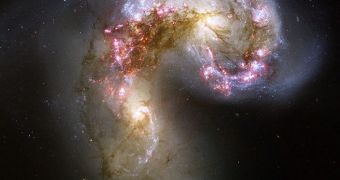One of the biggest unanswered questions regarding the Universe today is why there are two types of galaxies, one that has trailing spiral arms, such as our own Milky Way, and one that looks more like a compact ball of stars, known as a barrel galaxy. Astronomers have struggled with this question for a long time, and now they have finally decided to enlist the help of the general public on the issue. Researchers at the George Mason University and Oxford University have recently developed a new site, which allows amateur scientists to view millions of pictures of galactic mergers, or collisions.
The new site is called Galaxy Zoo Mergers and it just went online yesterday. It is played like a “cosmic slot machine,” in which citizen scientists compare images of galactic cannibalism with millions of other simulated pictures of mergers, designed by computer models. Basically, what the new website does is allow its users to do computer modeling of galaxies to determine how a collision happened. The GZM is a spinoff from an earlier international project, called Galaxy Zoo, which allowed everyone to help categorize the known galaxies of our Universe with just a few clicks.
“Visitors to the Galaxy Zoo Mergers site use what's rather like a giant slot machine, with a real image of a galactic merger in the center and eight randomly selected simulated merger images filling the other eight 'slots' around it. By randomly cycling through the millions of simulated possibilities and selecting only the very best matches, our visitors are helping to build up a profile of what kind of factors are necessary to create the galaxies we see in the universe around us. And, hopefully, they are having fun, too!” GMU Associate Professor of Computational and Data Sciences John Wallin says.
“These volunteers that participate are not just users. They're doing science. They're doing the analysis we don't have time for, because there could never be enough professional astronomers to do the job properly,” Galaxy Zoo project leader Dr. Chris Lintott adds. The expert is based at the Oxford University, in the United Kingdom. “These collisions take millions of years to unfold, and so all we get from the universe is a single snapshot of each one. By producing simulations, we will be able to watch each cosmic car crash unfold in the computer. By reconstruct these collisions, our users will help us understand how galaxies have changed over the history of the Universe,” Wallin shares.

 14 DAY TRIAL //
14 DAY TRIAL //